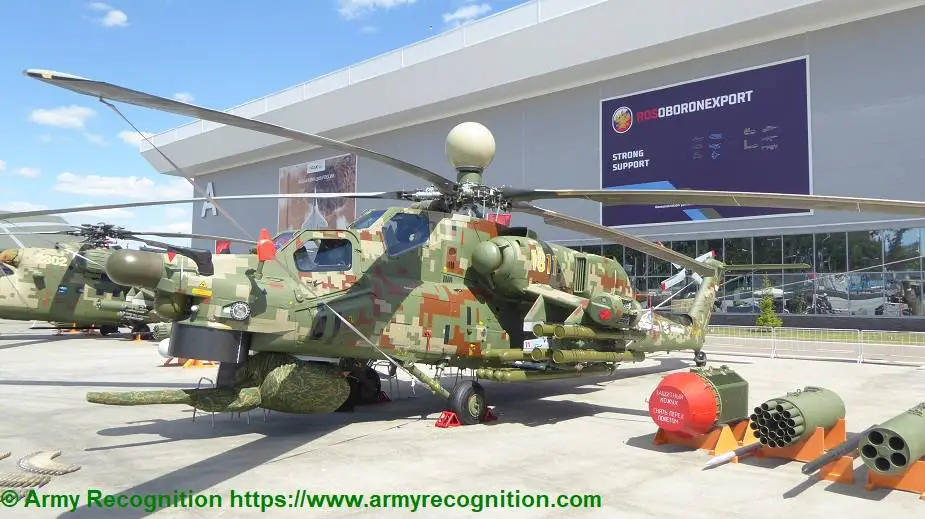Breaking news
Mi-28NM attack helicopter can fire new weapons and interact with drones - Part 1.
The Russian army received Mi-28NM helicopters, an upgraded Mi-28N. The Russian Helicopters Holding has to supply 98 rotorcraft. In June, Mi-28NM will fly at MAKS-2021 airshow. Chief Designer of Combat Helicopters program of the MiL and Kamov design bureau Vitaly Shcherbina told TASS about Mi-28NM capabilities.
Follow Air Recognition on Google News at this link
 Mil Mi-28NE. The upgraded Mi-28N/NE does not have the effectiveness of the Mi-28NM (Picture source: Army Recognition)
Mil Mi-28NE. The upgraded Mi-28N/NE does not have the effectiveness of the Mi-28NM (Picture source: Army Recognition)
It is not appropriate to compare Mi-28N and Mi-28NM, Vitaly Shcherbina said. Mi-28N ideology was created in the late 1980s on the basis of experience provided by the Afghan war and other local conflicts. The helicopter was created in conditions of a chronic lack of finances, which did not allow implementing everything in a full volume. “Mi-28NM has a different ideology and construction technologies. It is truly a new-generation helicopter,” Shcherbina said. Its weapons can destroy targets in any time of the day and weather without entering the air defense zone. The onboard defense complex protects against antiaircraft weapons. Telecommunications help helicopters interact in a group and operate in air and ground communication networks. Netcentric controls on the battlefield rapidly provide information about friendly and hostile troops in a protected jam-resistant regime.
Russian experts together with research institutes of the Defense Ministry and Aerospace Command have been analyzing the engagement experience of Mi-28N, Mi-35M, and Mi-28NM since the very beginning to increase the effectiveness of the helicopters.
Several guidelines to upgrade Mi-28N were determined. Firstly, it was necessary for the helicopter to survive in hostile electronic warfare and fire. Mi-28NM received a modern onboard defense complex to protect it against electronic impact and air defense fire.
Secondly, it was necessary to increase the tactical engagement radius. Mi-28NM has a bigger fuel stock and can carry additional protected fuel tanks.
Thirdly, the range of weapons had to expand. It can fire new-generation guided missiles that hit the targets in any time of the day without entering the hostile air defense zone, new-generation unguided missiles of higher firepower, and various-caliber bombs.
Fourthly, it was necessary to increase combat engagement autonomy. Mi-28NM has upgraded and automatically regulated VK-2500P engines designed by UEC-Klimov and the TA14-130-28 auxiliary power plant.
Fifthly, it was necessary to integrate the helicopter into a single digital information space of the battlefield to increase combat effectiveness. Helicopters are an element of reconnaissance-strike forces and can automatically receive vital information about the adversary and combat conditions in the assigned area.
“Breakthrough guidelines, which have not been researched completely, may yield interesting results. Light multirole guided missiles can be included in the round of munitions to destroy targets without entering the air defense zone. The helicopters can be included into the single digital information-reconnaissance space of the battlefield,” Shcherbina said. The Russian army received the Mi-28NM helicopter, which is an upgraded Mi-28N. The Russian Helicopters Holding has to supply 98 rotorcraft. In June, Mi-28NM will fly at MAKS-2021 airshow. Chief Designer of Combat Helicopters program of the MiL and Kamov design bureau Vitaly Shcherbina told TASS about Mi-28NM capabilities.
The combat engagement experience of Mi-28N, Mi-28NM, and Mi-35M was analyzed and is used by designers. It is premature to present it to foreign customers, as Russian specialists have themselves to analyze the accumulated knowledge and introduce new ideas and technologies into the design.
The above-rotor radar designed for Mi-28NM by Ryazan Instrument Plant of Radio-Electronic Technologies Concern (KRET) properly performed in combat conditions. It detected ground and water surface objects, adjusted coordinates of the helicopter flight in conditions of jammed satellite navigation channel, and provided guidance to all-weather weapons.
Mi-28NM and Mi-35M use new aerodynamic blades. They are another step to increase the general effectiveness of the helicopters. The blades have been installed on one Mi-28NM and flight trials began. Test pilots said the new aerodynamic blades decreased vibration and increased flight stability. No trials of the speed of the helicopter with composite blades of a new form have been held yet, but experts believe the blades will considerably increase the speed. However, they do not provide specific figures.
Mi-28NM tests with new missiles confirmed the high effectiveness of the weapons. Their combat engagement resulted in an action plan to simplify Mi-28NM fire and increase precision. An important guideline is to engage the missile together with a reconnaissance drone and an automatic command post initiated and designed by the Mil and Kamov bureau. It allows the pilot to choose target approach parameters (course, speed, altitude, and missile engagement echelon) in an automatic regime.
The basic Mi-28N has an analog control of the gun drivers. It produced the so-called bullwhip effect when the first projectiles hit the target and the rest disperse, as the drivers operate with a delay and thus decrease gun precision. Much work has been done to decrease the weight and size of Mi-28NM gun. The control of the drivers is now digital and more reliable. Designers and the military are satisfied with Mi-28NM gun.
Effective air-to-air guided weapons of Mi-28NM made it possible to perform circle-strafing aerobatics. It reduces the helicopter ground speed to zero and the crew occupies a convenient position to engage air-to-air missiles. Mi-28N is incapable of it because of the absence of corresponding weapons. New weapons and new capabilities to detect the adversary result in new Mi-28NM aerobatics.
© Copyright 2021 TASS. All rights reserved. This material may not be published, broadcast, rewritten or redistributed.

























